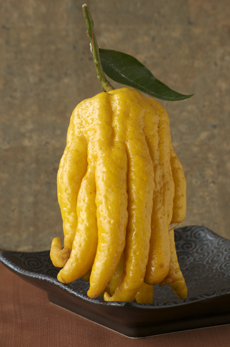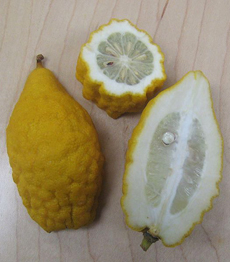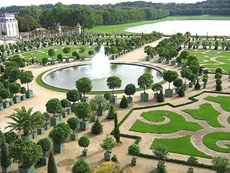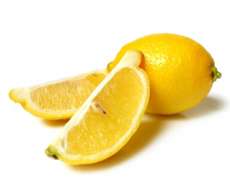

Buddha’s Hand, or finger citron, is a Chinese temple offering—and a fragrant ingredient. Photo by Evan Dempsey | THE NIBBLE.
March 2010
Last Updated November 2012
|
 |
Lemon Glossary ~ Different Types Of Lemon
Page 2: Citron, Citrus, Eureka Lemon & Other Lemon Terms From A To F
This is Page 2 of a five-page article about the different types of lemon. There are many different lemon cultivars: We’ve included the most prominent ones here. Click on the black links below to visit other pages. And see many more glossaries of your favorite foods.
This glossary is protected by copyright and cannot be reproduced
in whole or in part. You are welcome to link to it.
AVALON LEMON
A variety that originated in Florida and is similar to the Lisbon lemon, which is one of the two main types in supermarkets (along with the Eureka lemon).
BEARSS LEMON
The Bearss lemon tree is a true lemon tree believed to have originated in Italy, from a variety that is now extinct. It closely resembles the Lisbon lemon. Bearss was a Florida citrus grower; the current Bearss lemon was found in one of their groves near Lutz, Florida, around 1952. It is a popular variety for growers, due to the amount of fruit that each tree bears, its quality juice and, most importantly, the high percentage of lemon oil in its peel.
BUDDHA’S HAND or FINGER CITRON
Buddha’s Hand is an extremely fragrant, misshapen fruit indigenous to the lower Himalayas (see photo above left). In China, it is a traditional temple offering and symbol of happiness, longevity and good fortune. The culinary benefits are in the pith and rind; the fingers are all rind, without pulp or juice. While other varieties of citron look more conventional, they are similarly used for their pith and rind. See citron, below.
BUSH LEMON
A wild lemon from subtropical Australia, the bush lemon or rough lemon (botanical name Citrus jambhiri) is very hardy, with a thick bumpy skin (like citron, below) and a strong lemon flavor from the rind—similar to a true lemon. The bush lemon can be very low in juice, but often always features a much stronger-tasting flesh than other lemons. Its hardiness makes it a good rootstock for grafting other varieties. The bush lemon is self-seeding. This means that when the seeds fall to the ground in the right environment, they will germinate and grow the following spring.
CITRON
Citron is native to India near the border of Burma; it grows wild in the valleys at the foot of the Himalayas. It is a large fruit that can reach 8 to 10 pounds—so heavy that it can cause branches to break—and it does not fall from the tree.
Citron is different from most citrus in that it lacks the pulpy juiciness of more common citrus: It is very dry with just a bit of juice. Instead, it is used for its rind. The thick white pith is the most important part of the citron, used as an ingredient and candied as a gourmet treat. The oil found in the peel is used in fragrances. From ancient times, citron was used mainly for medical purposes, some of which included gastrointestinal upset, pulmonary disease and even seasickness; the oil from the peel was used as an antibiotic. Citron juice taken with honey was considered an effective antidote to poison (but don’t count on it!). |
|

Greek citron. Photo courtesy Wikimedia. |
There are actually three groups of citron varieties: The acidic pulp group (including balady citron, diamante citron, Florentine citron and Greek citron); the non-acidic pulp group that includes Corsican and Moroccan citron; and the pulpless varieties including Buddha’s hand and Yemenite citron. While citron may seem like a French word, the French name for citron is cédrat.
CITRUS
Citrus is a botanical family (Rutaceae) of fruits that includes grapefruit, lemon, lime, orange, pomelo and less familiar varieties. The genus Citrus includes popular hand fruits such as oranges (and its numerous species, including clementines, kumquats and tangerines) as well as acidic citrus like lemon and lime that are used as ingredients in recipes.
Citrus fruits are peeled and split into segments for eating; they are halved and juiced; or are quartered as garnish. Citrus trees are also used as houseplants; the Orangerie, a citrus hothouse with many glass panes to let in the light, was built in 1617 at the Louvre Palace under the reign of Louis XIII (from September 27, 1601 to May 14, 1643—his First Minister was Cardinal Richelieu). Orangeries permitted the aristocracy to stroll amid fragrant citrus trees and enjoy the fruits year-round. In the warm weather, the potted trees were moved outdoors. Orangeries became possible because glass-making technology had evolved to produce large enough panes of clear glass.
|
|

The park at Versailles with the Orangerie in the background. In the warm weather, the pots of orange trees were set outdoors—and still are, as can be seen in this photo. Photo courtesy Wikimedia. |
This inspired many aristocrats to build orangeries, that endured as horticultural models until the development of the modern greenhouse in the 1840s.
DORSHAPO LEMON
Dorshapo is a sweet lemon—a very low acid lemon or limetta. The cultivar was named after three plant explorers named DORsett, SHamel and POpenoe, who found it in Brazil in 1914. It is similar to the Eureka lemon (see below) except for the lack of acidity.
EUREKA LEMON
The Eureka (botanical name Citrus × limon) is the predominant lemon grown in most countries, with the exception of Italy, Spain and some other Mediterranean nations. It was first grown in Los Angeles in 1858, from a group of seedlings grown from fruit of Italian origin, believed to be the Lunario lemon. In 1877 it was propagated by Thomas Garey, who named it “Garey's Eureka.” Since then, different horticulturists have propagated varieties of the Eureka. Because the tree is thornless and a year-round bearer, it came to rival the then-predominant Lisbon variety (which looks similar, but the Eureka has a far more prominent nipple end—you can see the prominence in portion protruding from the to of the lemon quarter in the photo).
|
|

Eureka lemon. Photo by Zsuzsanna Kilian | SXC. |
Both species have remained the principal varieties in California and in many places around the world. See Lisbon lemon for the differences between the two varieties.
FINGER CITRON
See Buddha’s Hand.
FINO CITRON
A vigorous variety of lemon, but less popular because the branches have large thorns and the fruit has a medium quantity of seeds (as opposed to few seed). The fruit is smaller and has less juice than the Verna lemon, which it resembles; however, the juice is of very high quality and acidity. The tree typically fruits twice a year.
Continue To Page 3: Varieties Of Lemon ~ G To L
Go To The Article Index Above
Some information courtesy of Purdue University. Copyright 2005-
Lifestyle Direct, Inc. All rights reserved. Images are the copyright of their respective owners.

|







